The Eletre is expected in the US in 2024 with 600 hp and in excess of 300 miles of reach.

This week we figured out what an electric Lotus SUV will resemble when the organization flaunted another vehicle called the Eletre.
Not every person will seriously love the styling, and others will simply have a problem with the possibility of Lotus making a SUV, electric or in any case, in any case.
Be that as it may, keep a receptive outlook, essentially until the principal street tests.
However long it drives like a Lotus, it very well may be only what to carry a great deal of new clients to the marque, in Europe and China as well as here in the US from 2024.
What's more, as Porsche so capably illustrates, it's a decent method for paying for the stuff that causes vehicle geeks to get angry as a mad bull.
The English producer of lightweight games vehicles has been in a surprising position these most recent couple of years — adequately subsidized, on account of the very abundant resources that restored Volvo.
Rather than warming over an inexorably old stage for little two-seaters, Lotus got to work creating not one however four new structures.

One of those is for the as of late uncovered Emira, Lotus' last gas powered motor controlled sports vehicle.
Another is for hypercars that couple of us will at any point see, and a third is for electric games vehicles, with a battery design that amasses the cells in a taller "chest" behind the lodge, as opposed to a level section underneath the whole floor.
In any case, a level section of batteries between the axles and under the floor is by and large the thing you'll find inside the Eletre, a SUV that will be the principal vehicle to utilize Lotus' fourth stage.
A really respectable section, as well — a little more than 100 kWh, to give it a WLTP scope of 600 km; expect serenely in excess of 300 miles of EPA range all things considered.
Every pivot gets its own electric drive unit, with somewhere around 600 hp (447 kW) accessible to the driver.
The powertrain runs at 800 V, and supports 350 kW DC quick charging to charge from 20-80 percent in a short time.

Prominently, there's no notice of a control weight.
I anticipate this will fuel skeptics, however reality these days is that air suspension and electric engines conceal a lot of a vehicle's mass from the driver, and regenerative slowing down implies there's very little punishment for the sort of speed increase that gets you to 60 mph in three seconds.
The Eletre will likewise flaunt back pivot controlling, force vectoring, and some other dynamic undercarriage tuning, all in the guide of nimbleness.
The man accountable for ensuring the Eletre handles well is Gavan Kershaw, and on the off chance that you like the manner in which ongoing Lotuses drive, he's the man to thank.
"Progressively, the Eletre has been created to convey all that you would anticipate from a Lotus — extraordinary ride and taking care of, profoundly informative controlling, and outstanding driver commitment," he said.
Since I'm vocal about the way that electric vehicles should have better controlling, that sounds promising.
The studio pictures you see highlight the Eletre with side-view cameras rather than intelligent mirrors.
These stalks additionally bundle cameras, some for low-speed stopping and others that work couple with "deployable" lidar sensors that Lotus says will empower some level of independent driving on schedule.
The pictures additionally show a severe four-seater, with a couple of energetic looking container seats toward the back.
The inside gives off an impression of being a move forward for Lotus — for over twenty years its vehicles have seldom even highlighted floor coverings.
Maintainability and light weight are the two key ascribes, with microfibers and fleece rather than calfskin.
What's more, fascinating materials proliferate, including pieces of carbon-fiber texture that would some way or another be squander, used to make composite trim boards.
Promoted Comments
- shelbystripes wrote:I don’t get the hate on luxury makers building SUVs. It’s not like Lotus has ever built a practical car before. They’re just building a different kind of impractical vehicle now. It’s still going to be ridiculously overpowered and have a lower center of gravity than actually practical daily-driver alternatives.Quote:The images also show a strict four-seater, with a pair of sporty-looking bucket seats in the back.
Car & Driver says a five-seat version with a rear bench seat will also be offered.
I’m a Porschephile. I remember when talk of the Cayenne first started I was pissed. A few years later when Porsche was killing it financially and using the profit from the Cayenne to build ever more awesome 911 variants and then the Cayman I was no longer pissed.








0 Comments
Write a comment if you liked the topic